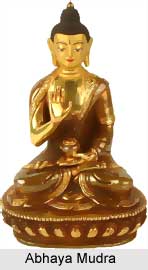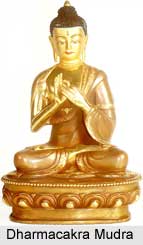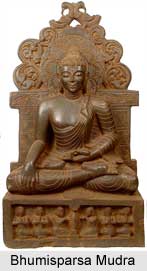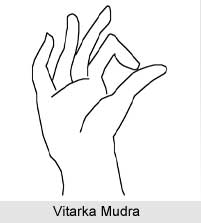 The Mudras are a series of symbolic or ritualistic hand gestures, describing the actions of the characters represented in only the most interesting Buddhist art. A collection of some of the Buddhist mudras are as follows:
The Mudras are a series of symbolic or ritualistic hand gestures, describing the actions of the characters represented in only the most interesting Buddhist art. A collection of some of the Buddhist mudras are as follows:
Abhaya Mudra
The Abhaya mudra ("mudra of no-fear") represents protection, peace, generosity, and driving away of fear. In the Theravada it is normally made with the right hand raised to the shoulder`s height, the arm bent and the palm facing outward with the fingers erect and joined and the left hand hanging down on the right side in a standing position. Abhaya mudra was in all probability used before the oncoming of Buddhism as a symbol of good intents, proposing friendship when approaching strangers. In Gandhara Art it is witnessed when showing the action of prophesying. The gesture was used by the Buddha when attacked by an elephant, taming it as shown in various frescoes and scripts. In Mahayana the northern schools` deities frequently put it to use with another mudra paired with the other hand.
Dharmacakra Mudra
The Dharmacakra mudra represents a primal moment in the life of Buddha when he preached his first sermon after his Enlightenment, in Deer Park in Sarnath. Gautama Buddha is normally only depicted making this mudra, except Maitreya as the dispenser of the Law. The Dharmacakra Mudra position symbolises the turning of the wheel of the Dharma. Dharmacakra mudra is created when two hands close together in front of the chest in Vitarka having the right palm forward and the left palm upward, at times facing the chest.
 There are umpteen variants such as in the frescoes of Ajanta caves, India, where the two hands are separated and the fingers do not touch. In the Indo-Greek style of Gandhara the clenched fist of the right hand apparently overlie the fingers joined to the thumb on the left hand.
There are umpteen variants such as in the frescoes of Ajanta caves, India, where the two hands are separated and the fingers do not touch. In the Indo-Greek style of Gandhara the clenched fist of the right hand apparently overlie the fingers joined to the thumb on the left hand.
Dhyana Mudra
The Dhyana mudra ("meditation mudra") is the gesture of meditation, of the concentration of the Good Law and the sangha. The two hands are stationed on the lap, right hand on left hand, with fingers wholly unfolded and the palms facing upwards, shaping a triangle, emblematical of the spiritual fire or the Triratna, the three gems. This mudra is used in representations of the Sakyamuni Buddha and Amitabha Buddha. Sometimes the Dhyana mudra is used in particular representations of Bhaisajyaguru as the Medicine Buddha, with a medicine bowl placed on the hands. It originated in India most probably in Gandhara. This mudra has been in use long before the Buddha, as yogis have used it during their concentration, healing, and meditation exercises. Dhyana mudra is also known as Samadhi mudra or Yoga mudra.
Varada Mudra
The Varada mudra ("favourable mudra") connotes offering, welcome, charity, giving, concern and sincerity. It is almost always used with the left hand for those who dedicate oneself to human salvation. It can be made with the arm crooked, the palm slightly turned up or in case of the arm facing down, the palm presented with the fingers erect or slightly bent. The Varada mudra is seldom seen without using another mudra used by the right hand, characteristically with the Abhaya mudra. It is much mixed up with the Vitarka mudra, which it closely resembles
 . In India the mudra is used in images of Avalokitesvara from the Gupta Period of the 4th and 5th centuries. The Varada mudra is used in a widespread manner in the statues of Southeast Asia.
. In India the mudra is used in images of Avalokitesvara from the Gupta Period of the 4th and 5th centuries. The Varada mudra is used in a widespread manner in the statues of Southeast Asia.
Vajra Mudra
The Vajra mudra ("thunder mudra") is the gesture of knowledge. It is formed by making a fist with the right hand, index stretching upward, and the left hand also making a fist and enveloping the index. A good instance of the application of the Vajra mudra is the seventh technique (out of nine) of the Nine Syllable Seals, using the mudra with mantras in a ritualistic application.
Bhumisparsa Mudra
The Bhumisparsa mudra ("earth-touching mudra") literally represents the Buddha as taking the earth as witness. It represents the moment when Buddha took the earth as evidence when he had settled the problem of cessation of suffering when he was under the peepal tree at Bodh-Gaya. Bhumisparsa mudra is generally represented by the historical Buddha and Aksobhya (in Vajrayana Buddhism aksobhya is one of the Five Wisdom Buddhas, a product of the Adibuddha, who represents consciousness as an aspect of reality) sitting in the lotus position. The right hand touches the ground with the fingertips near the right knee stretched, or with only the index finger pointing down touching the ground with the left hand normally resting on the lap with the palm facing up. The mudra can also represent the vanquishing of the demon horde of Mara. Aksobhya is frequently seen using this mudra while clasping part of his robe with his left hand.
Vitarka Mudra
The Vitarka mudra ("mudra of discussion") is the gesture of discussion and transmission of Buddhist doctrines.
 It is done by joining the tips of the thumb and the index together, and keeping the other fingers straight, very much like Abhaya and Varada mudras, but with the thumbs touching the index fingers.This mudra has a great number of variances in Mahayana Buddhism in East Asia. Vitarka mudra is also known as Prajnalinganabhinaya, Vyakhyana mudra ("mudra of explanation");
It is done by joining the tips of the thumb and the index together, and keeping the other fingers straight, very much like Abhaya and Varada mudras, but with the thumbs touching the index fingers.This mudra has a great number of variances in Mahayana Buddhism in East Asia. Vitarka mudra is also known as Prajnalinganabhinaya, Vyakhyana mudra ("mudra of explanation");
Jnana Mudra
The Jnana mudra ("mudra of knowledge") is formed by touching the tips of the thumb and the index together, establishing a circle, the hand is held with the palm inward toward the heart.
Karana Mudra
The Karana Mudra routs out demons and removes hindrances like sickness or negative thoughts. It is made by raising the index and the little finger, and folding the other fingers. This mudra is also known as Tarjana mudra.



















